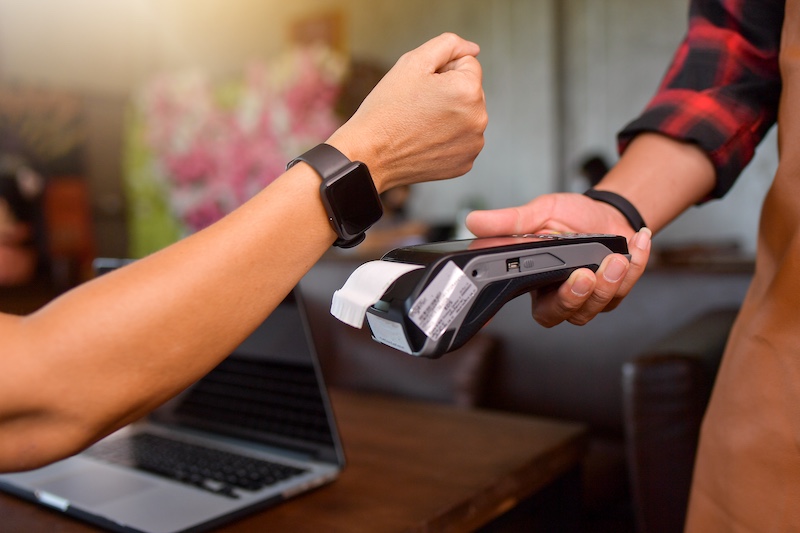Once considered the domain of science fiction, wearable devices are now an increasingly common medium for facilitating secure payments on the go. RFID-enabled smartwatches, wristbands and jewelry enable today’s users to conduct banking activities without needing physical cards or cash. The growing popularity of contactless transactions since the COVID-19 pandemic makes adopting this technology viable on a broader scale.
Delve into the dynamic landscape of RFID wearables, exploring their pivotal role in driving this evolution and shaping the future of banking.
RFID Technology Applications in the Banking Sector
The popularity of wearable banking has soared in recent years, with an estimated 16.8 percent compound annual growth rate by 2032. This demand surge has prompted financial institutions to introduce innovative applications that leverage RFID systems into their service offerings.
No-Touch Payments. RFID-enabled wearables facilitate contactless payments, offering a swift and secure transaction experience. For example, Mastercard’s Tap & Go feature utilizes advanced RFID technology to enable customers to make quick payments by tapping their devices on compatible merchant terminals. The embedded smart chip relays the account information to the receiving antenna and processes the payment automatically.
Courier Tracking. Many banks utilize RFID tags to track couriers transporting valuable assets such as cash, IT equipment and documents. Information scanned onto the dispatcher’s smartwatch or fitness bracelet can help officials monitor the identification and movement of each of these deliverables in real time.
Authentication and Security. Accessing online banking features always carries some inherent risk, but RFID wearables add an extra element of security to make it safer and more reliable. For example, the device can be a physical token that pairs with biometrics to strengthen the authentication process. Wearables can also store encrypted data, such as access codes or keys, transmitted securely when the device is authenticated.
Identifying High-Value Clients. Financial institutions may use RFID tags on key fobs and other wearable devices to identify wealthy clients and provide them with special treatment. When these high-networth individuals enter the bank, sensors read the tags at the entrance, notifying employees that a VIP client is present.
The Role of RFID in Enabling Wearable Banking Tech
The unique features of RFID make it a natural fit for integration into wearable devices, providing users with convenient and efficient banking experiences. Key features include:
- Wireless communication: RFID technology operates wirelessly through radio frequency identification, allowing wearables to communicate with terminals without physical contact. This feature is essential for facilitating seamless and convenient transactions.
- Compact size and low power consumption: RFID tags are typically compact, making them suitable for integration into wearables. They also require minimal power to operate, which is crucial for maintaining the device’s energy efficiency and longevity.
- Long read range: RFID wearables benefit from having a read range of about 300 feet, enabling efficient and secure banking transactions at a distance.
- Versatile design: RFID wearables come in diverse styles, allowing users to select a device that aligns with their fashion preferences. From sleek smartwatches with customizable faces to trendy key fobs and fashionable jewelry, there’s a wide range of options available for consumers to express their individuality.
Drawbacks and Considerations
Despite its promising rise in popularity, RFID technology still has a few barriers preventing widespread adoption.
Compatibility. Compatibility with existing payment infrastructure and other banking services is a crucial concern. Although contactless merchant terminals are becoming increasingly ubiquitous, some establishments may only accept traditional card or cash payments. Such instances negate the need for RFID wearables at the time of purchase.
Cybersecurity Risks The data transmitted between RFID devices is vulnerable to interception and theft, necessitating robust security measures. Malicious actors can also take advantage of information in RFID-enabled devices to track individuals wearing them, potentially exposing them to physical harm.
Battery Life. Battery life is a crucial factor to consider when choosing an RFID wearable device. While RFID wearables generally offer decent battery performance, selecting a device that matches individual usage habits is essential. For instance, frequent users requiring extensive functionality may benefit from devices with extended battery life or convenient recharging features.
The Future of Wearable Banking Tech
The possibilities for wearable tech are endless. With the rapid progress in innovations like augmented reality glasses and biometric clothing, the horizon for wearable tech in banking is expansive and promising. These advancements blur the lines between fashion and technology while paving the way for enhanced user experiences and personalized services.
However, user adoption remains a challenge. Concerns about privacy, security and the overall usefulness of these devices make consumers hesitant to embrace them. Improvements in RFID technology and continued integration into everyday processes will be vital to shifting user attitudes toward wearable tech.
RFID technology has ushered in a new era of possibilities for wearables. As innovation advances, a new wave of applications appears on the horizon, promising to reshape how people communicate and make transactions. Embrace the potential of wearable tech to unlock limitless possibilities in banking.


